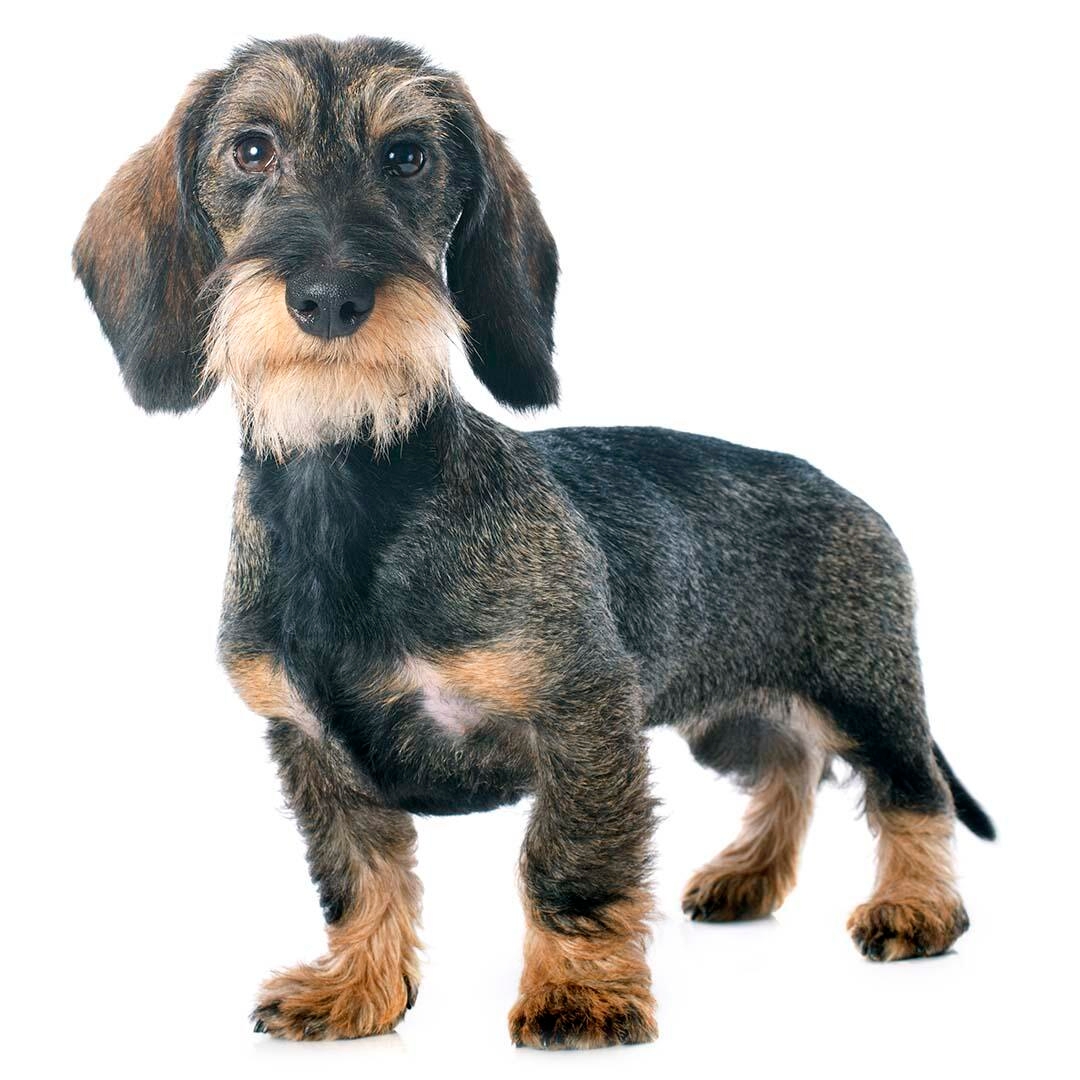
| Family-friendly: | 4/5 |
| Exercise needs: | 3/5 |
| Easy to train: | 2/5 |
| Tolerates being alone: | 3/5 |
| Likes other pets: | 3/5 |
| Energy level: | 3/5 |
| Grooming needs: | 3/5 |
| Shedding: | 3/5 |
The most common health problem seen in the Dachshund is related to their body shape - with their long backs and short legs they are more prone to spinal disorders and joint problems;
- Intervertebral disc disease: a condition where there is abnormality in the discs which act to cushion the bones in the spine. The discs can dislodge or burst, which puts pressure on the nerves in the spinal cord leading to back pain and weakness or paralysis of the limbs.
- Angular limb deformities: caused by asynchronous growth of a pair of bones, which appear bowed or rotated and may result in pain and lameness.
Miniature Wire Haired Dachshunds are also prone to:
- Cushing's syndrome¹, which is where too much natural steroid hormone (called cortisol) is produced, leading to symptoms such as excessive drinking and tiredness.
- Progressive Retinal Atrophy which is an inherited disorder where part of the eye degenerates and wastes away which can result in blindness.
- Lafora's epilepsy which is an inherited condition where carbohydrates cannot be broken down resulting in toxin build up and nervous signs.
Priority Kennel Club health schemes and testing:
- DNA testing for progressive retinal atrophy which tests whether or not a dog has the potential to be affected by this condition.
- DNA testing for Lafora's which is a type of inherited epilepsy.
- IVDD Scheme for Dachshunds
¹G. Carotenuto et al, 'Cushing’s syndrome—an epidemiological study based on a canine population of 21,281 dogs', 2019, Open Veterinary Journal
This dog can be very independent and needs kind, consistent, patient training. Early socialisation is required in order to acclimate Miniature Wire-Haired Dachshunds to children, strangers and other animals. They are a breed that becomes very attached to their family and usually one family member in particular, but they can be reserved with strangers.
The Dachshund will suit an owner who may not have much space but wants a strong-minded, determined, one-person dog who will go everywhere with them - as the Dachshund does not like being left.
| Family-friendly: | 4/5 |
| Exercise needs: | 3/5 |
| Easy to train: | 2/5 |
| Tolerates being alone: | 3/5 |
| Likes other pets: | 3/5 |
| Energy level: | 3/5 |
| Grooming needs: | 3/5 |
| Shedding: | 3/5 |
Dachshunds can be traced back to 15th century Germany. However, Dachshund-type dogs have appeared in ancient Egyptian and Mexican art and remains of a similar dog were found with shipwreck remnants in Italy, dating back to the 1st century AD. The German breed standard was set in 1879 and the breed club established in 1888. Dachshunds were exported to Great Britain with Prince Albert and became popular in Britain and America throughout the 19th century. Miniature Dachshunds were used in lieu of ferrets to hunt rabbits out of their warrens.
The Miniature Dachshunds are a little less robust than their standard counterparts – easier to pick up, but also easier to trip over. Owners will need to be reasonably fit and active, interested in some fun training. The Wire-haired will need their coat clipping/stripping and rolling, which can be done at home or by a professional groomer. This breed doesn’t cope well with stairs and is best suited to single storey living.
This dog needs a minimum of half an hour's daily exercise. Before letting them off-lead, do ensure their recall is reliable, as their hunting instincts can drive them to run off in pursuit of a scent or quarry or just be selectively obedient. Bear in mind that Dachshunds were bred to 'go to ground' and can dig under many types of fencing, so check your garden's security.
The Miniature Dachshund doesn’t need much space but needs access to the outdoors for exercise and toileting - and enjoy a small garden. Their shape means that they do better in a bungalow or single-story flat as stairs can put strain on their long backs.
Toy-sized dogs have a fast metabolism, meaning they burn energy at a high rate, although their small stomachs mean that they must eat little and often. Small-breed foods are specifically designed with appropriate levels of key nutrients and smaller kibble sizes to suit smaller mouths. This also encourages chewing and improves digestion.
Miniature Wire Haired Dachshunds are fairly low-maintenance; they should be groomed twice a week to remove dead hairs.
Dachshunds are not the greatest pupils - although with patient reward-based training, can be surprisingly trainable - but should at least be taught basic life skills - including walking on a harness and lead. Socialisation with other people is important as they can be reserved to the point of unfriendly with strangers.
The Miniature Dachshund doesn’t make a good family dog - especially with young children - as they are prone to injury, sometimes short-tempered, and doesn’t enjoy boisterous games. They generally bond closely to one person rather than to a family. With older or dog-savvy children however they can be a good companion - although will probably always have their favourite.
While many dogs are traditionally thought of as being good with children, all dogs and children need to be taught to get on with and respect each other, and be safe together. Even so, dogs and young children should never be left alone together and adults should supervise all interactions between them.